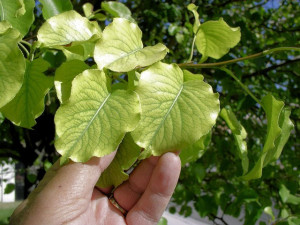By Jim Downer
Trees are valuable elements of landscapes. As they grow, they increase in size and value as well as in cost of maintenance. Young trees demand little water and fertilization, but growing trees and old trees may deplete water and nutrients from soil.
This is especially true in agriculture, where yields are taken from the tree and are not recycled into soils as organic nutrients. It can also be true in landscapes when trees are thinned or over-pruned frequently. The yield is in branches and leaves removed from the tree and the landscape system.
Many landscapes contain hardscape, decks, sidewalks, roads or other impervious elements that do not allow for mulching and organic nutrient recovery from fallen leaves. Further, adjacent landscape plantings such as turfgrass, shrubs and color beds can extract nutrients that would otherwise be utilized by trees. Thus it is sometimes necessary to fertilize landscapes to maintain quality of trees or other plantings.
What are the factors that affect the need to fertilize? There are many. First and most important is the genetics of the trees which are being grown. The more adapted a tree is to its growing location, the less need there will be to alter the nutrient regime for that tree.
Poorly adapted trees may develop chlorotic (yellowed) leaves, become stunted or show edge necrosis on their leaves. Some intervention with fertilizers may be necessary.
When possible plant adapted species to avoid nutrient conflicts. Edaphic factors such as soil depth, texture, slope or aspect, and mineral content may all affect the mineral requirements of trees. Irrigation methods and scheduling also affect fertilization programs. Finally the presence of mulch will greatly affect the need to fertilize.
Some trees prefer acid soils. Redwoods, maples, rhododendrons, gardenia, camellia, and some oak species prefer slightly acidic soils. If trees are chlorotic (interveinal chlorosis) and the soil reaction is alkaline (> pH 8.0) some attempts to reduce soil reaction should be made.
Clay soils are usually buffered, and will require more soil sulfur or acid forming fertilizer to reduce pH than sand or loamy soils. Alkaline soils make metals such as manganese, iron and zinc less available to plants especially sensitive species such as make and some of the Eastern oaks.
While it is tempting to add iron when chlorosis is present, it usually will not relieve the deficiency. Reducing soil reaction with granular soil sulfur works best, but takes some time (about a year).
Soils low in organic matter will acidify slower than soils with organic matter added (as mulch or amendments). Organic matter increases the microbial activity of soil and assists microbes in mineralizing the sulfur to sulfuric acid, thus reducing pH.
Ammonia containing fertilizers can also acidify soils. Ammonium ion or Urea which is rapidly converted to ammonium is acidifying in soil. As ammonium is oxidized to nitrate in soil, it loses hydrogen ions into soil solution and thus causes an acid reaction.
Gypsum aka calcium sulfate is often recommended for all kinds of soil amending, but does not change soil reaction since the sulfur is already fully oxidized to sulfate and can react no further in oxygenated soil.
Well water with excess bicarbonate can also cause an alkalinity problem for plants. Acidifying irrigation water is helpful, but often not practical, so keeping on an ammonium-based fertilizer program with added soil sulfur will help prevent lime-induced chlorosis.
Sometimes nutrients are lacking in soil to the extent that trees develop deficiency symptoms. This can be because soils are shallow, poorly formed or have been removed (cuts and fills), leaving the growing substrate inadequate for tree growth. In these situations, adding organic mulches (a slow-release form of minerals) and supplementing with inorganic all-purpose fertilizers will allow for adequate growth of most trees.
Nutrient deficiencies can also occur in over-watered or waterlogged soils because plants can’t absorb nutrients when their roots are in hypoxic (low oxygen) conditions. Reducing irrigation frequency can be an effective way to restore soil nutrient levels.
Another cause of deficiencies is root rot. Trees with root rot can also display a variety of symptoms from wilt to chlorosis and leaf loss. Infected roots are not able to selectively absorb the nutrients needed and thus root rot affected trees can show deficiency symptoms in leaves.
A final word should be said about drought. When there is little rainfall and leaching of salts from soils, this is a time when soil salinity is likely increasing in many of the dry parts of the southwest. These soils must be very carefully fertilized because adding fertilizer is adding more salt and can make conditions worse for trees. Trees showing edge necrosis (death) on older leaves should not be fertilized or fertilized very carefully to address specific needs. Never fertilize a “dry” tree; this is very detrimental.
Dr. Jim Downer is an pathologist and advisor for the University of California Cooperative Extension in Ventura, CA.
